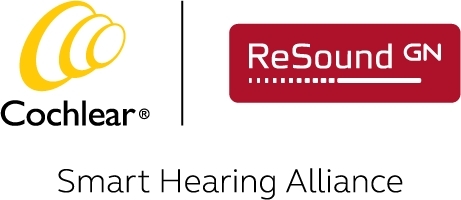BALLERUP, Denmark & SYDNEY--(BUSINESS WIRE)--GN Hearing, the global leader in hearing aid connectivity, and Cochlear, the global leader in implantable hearing solutions, together with Google, today announce world-first support for direct streaming from Android™ devices to hearing devices using Bluetooth® Low Energy (BLE).
The new technology is based on a recent hearing aid specification, Audio Streaming for Hearing Aids (ASHA) on Bluetooth Low Energy Connection-Oriented Channels, which Google has developed in collaboration with GN Hearing and Cochlear. This new direct streaming technology from compatible* Android devices allows people to use their hearing devices like a headset to enjoy music, take calls and much more, while using a protocol designed to maximise battery life.1 With BLE, people can use technology designed for streaming all day while preserving the battery life of their hearing devices, which is a challenge for the traditional Classic Bluetooth streaming currently available.
Around 466 million people worldwide live with disabling hearing loss**, and the number is increasing by millions every year, according to the World Health Organization.2 With the official release of Android 10, Google Pixel 3, Pixel 3 XL, Pixel 3a, and Pixel 3a XL* will be the first Android phones to support direct streaming to ReSound LiNX Quattro™ and Beltone Amaze™ hearing aids and the Cochlear™ Nucleus® 7 Sound Processor. The new streaming technology will be available by way of an update to Android 10, plus a firmware update on the hearing devices. The streaming specification is open source, which allows other manufacturers of hearing aids and Android devices to offer direct audio streaming in the near future.
“The streaming capability with the latest hearing devices from Cochlear or GN Hearing expands accessibility to more consumer technology. The benefit to our users is they will no longer have to use an intermediate device to stream audio from a compatible Android device to their cochlear implant sound processor or hearing aid,” says Jan Janssen, Chief Technology Officer, Cochlear.
“We’ve partnered up with some of the leading technology companies in the world to deliver innovation with the user at heart. Now people with hearing loss can enjoy effortless streaming all day long and easily connect with people,” says Jakob Gudbrand, CEO and President of GN Hearing.
- ENDS -
NOTES TO EDITORS
About GN
The GN Group is a global leader in intelligent audio solutions that let you hear more, do more and be more than you ever thought possible. Our ambitious 150-year journey has taken us from telegraph cables to radio waves and intelligent audio engineering. To celebrate our anniversary, we look to our unique competences within medical, professional and consumer audio solutions to help us continue to transform lives through the power of sound.
GN was founded with a truly innovative and global mindset. Today, we honor that legacy with world-leading expertise in the human ear, sound, wireless technology, miniaturization and collaborations with leading technology partners. GN's solutions are marketed by the brands ReSound, Beltone, Interton, Jabra and BlueParrott in 100 countries. Founded in 1869, the GN Group employs more than 6,000 people and is listed on Nasdaq Copenhagen (GN.CO).
Visit our homepage GN.com - and connect with us on LinkedIn, Facebook and Twitter.
About Cochlear Limited (ASX: COH)
Cochlear is the global leader in implantable hearing solutions. The company has a global workforce of more than 3,500 people and invests more than AUD$160 million each year in research and development. Products include cochlear implants, bone conduction implants and acoustic implants, which healthcare professionals use to treat a range of moderate to profound types of hearing loss.
Since 1981, Cochlear has provided more than 550,000 implantable devices, helping people of all ages, in more than 100 countries, to hear. www.cochlear.com
Please seek advice from your medical practitioner or health professional about treatments for hearing loss. They will be able to advise on a suitable solution for the hearing loss condition. All products should be used only as directed by your medical practitioner or health professional. Not all products are available in all countries.
© 2019 GN Store Nord A/S. All rights reserved. Jabra and BlueParrott are trademarks of GN Audio A/S. ReSound is a trademark of GN Hearing A/S. Beltone is a trademark of GN Hearing Care Corporation. All other trademarks included herein are the property of their respective owners (design and specifications are subject to change without notice).
© Cochlear Limited 2019. All rights reserved
The trade name for cochlear implants manufactured by Cochlear is the Cochlear™ Nucleus® series cochlear implants.
Cochlear, Hear now. And always, Nucleus, the elliptical logo and marks bearing an ® or ™ symbol, are either trademarks or registered trademarks of Cochlear Limited (unless otherwise noted).
Android is a trademark of Google LLC.
The Bluetooth® word mark and logos are registered trademarks owned by Bluetooth SIG, Inc. and any use of such marks by Cochlear Limited and GN Hearing is under license.
References
- Cochlear Limited. D1140877. Battery Life and Power Consumption Comparison between CP1000, CP900 Series and CP810 Sound Processors. 2017, Mar; Data on file.
- World Health Organization (WHO): deafness and hearing loss, March 2019. Available at https://www.who.int/news-room/fact-sheets/detail/deafness-and-hearing-loss. Last accessed August 8, 2019.
* For compatibility information and devices visit www.cochlear.com/compatibility and www.resound.com/compatibility. Full streaming compatibility with Android devices requires minimum Android version 10 and Bluetooth 5.0 and that functionality has been enabled by the phone manufacturer and service carrier. Accordingly, the compatibility information provided should be used for reference only. Although Cochlear and GN strive to achieve seamless device compatibilities, Cochlear and GN cannot guarantee full compatibility with all Android devices.
**Disabling hearing loss refers to hearing loss greater than 40dB in the better hearing ear in adults and a hearing loss greater than 30dB in the better hearing ear in children.



